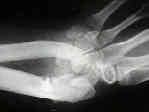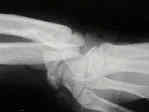- Discussion:
- known as carpus curves, is result of epiphyseal arrest on ulnar & volar half of the distal radius, which causes articular surface to be
directed ulnarward and volarward;
- genetics: it is inhertited as autosomal dominant trait w/ variable expressivity;
- females are affected four times as often as males;
- pathophysiology:
- it is caused by an absence or underdevelopment of ulnar portion of growth plate of the radius, so that it fails to contribute to linear
growth of the corresponding border of the radial diaphysis;
- exact cause of this localized growth disturbance has not been determined, but hemiatrophy of the epiphysis of the distal radius,
abnormal muscle insertions, and dysgenesis of vasuclar supply to epiphysis have been suggested;
- involved radial and dorsal portions of the growth plate continue to grow;
- faster growing, newly formed bone bends toward area of slower growth, causing the articular surface of distal radius to slant in
palmar and ulnar direction;
- associated conditions:
- Madelung's dyschondrosteosis:
- a type of mesomelic dwarfism should be suspected if condition is bilateral or if there is positive family history, short stature,
or mesomelia;
- diff dx:
- multiple exostoses;
- Ollier's disease;
- multiple epiphyseal dysplasia;
- Clinical Manifestations:
- characterized by insidious onset of pain in one wrist, then in other, and increasing prominence of the dorsal ulnar head and bowing
of distal radius;
- pain from radioulnar subluxation or radiolunate impingement usually becomes less severe at maturity;
- pain and mild deformity can be treated with distal ulnar resection;
- in presence of normal distal ulna - thus making wrist appear subluxed;
- it is bilateral in two thirds of patients;
- deformity progresses until growth plate of the distal radius closes;
- wrist motion, particularly extension and supination, is limited;
- pain usually subsides at maturity, but when the deformity becomes stabilized, the incongruity of the joint surfaces in the wrist may
lead to the recurrence of painful symptoms;
- although Madelung's deformity is considered a congenital deformity, it does not become manifest until late childhood or early
adolescence;
- Radiographs:
- increase in the normal palmar and ulnar inclination of distal radius
- ulna is unaffected and remains in its usual dorsal position;
- variants:
- in some cases, there will be atrophy of the radial head and hypertrophy of the capitellum;
- Non Operative Treatment:
- observation is indicated early on, especially if patient is asymptomatic;
- Treatment options:
- darrach procedure
- Darrach procedure has provided excellent relief of symptoms, but carries w/ it the problem of ulnar translation of the carpus;
- osteotomy of the distal radius
- in the report by Salon A, et al (2000), the authors report on 11 wrists with
painful Madelung deformity that were corrected during adolescence by a closing wedge osteotomy of the radius and a
shortening osteotomy of the ulna, with conservation of the distal RU joint;
- at late follow-up (9.7 years) function was considerably improved;
- when the ulnar head was correctly relocated during operation, a new distal radioulnar space developed;
- the authors emphasize that shortening of the ulna must be generous and combined with slight flexion at the osteotomy;
- ref: Long-term follow-up of surgical correction of Madelung's deformity with conservation of the distal radioulnar joint in teenagers
- in the report by Fernandez DL, et al, 12 wrists in 10 patients with a mean age of 23.6 years were treated for symptomatic increased
ulnar inclination of the joint surface with corrective osteotomy of the radius;
- diagnoses included mild ulnar dysplasia, posttraumatic deformity, Madelung's disease, and multiple hereditary exostosis;
- all patients had radial-sided wrist pain and an ulnarly displaced arc of radioulnar deviation. Preoperative radiographs showed
excessive ulnar inclination of the distal radius, ulnar carpal translation, adaptive carpal malalignment, and frequent
distal radioulnar joint incongruency;
- patients had decreased pain and improved wrist function at a mean of 5.1 years (range, 2-10 years) after surgery;
- average radial deviation changed from 3° to 16° and ulnar deviation from 48° to 29°; flexion/extension and pronosupination
remained unchanged;
- realignment of the wrist was shown radiographically by a change of ulnar inclination of the radius from 33° to 21°, an increase
in scaphoid height from 16.4 to 20.4 mm, and reversal of ulnar carpal translation as shown by an increase in lunate-covering
ratio of 64% to 77%;
- reduction of the ulnar inclination to normal values by corrective radial osteotomy restores a more physiologic range of
motion, decreases symptomatic wrist pain, reverts adaptive carpal changes to normal, increases lunate coverage, and may
prevent abnormal cartilage overload in the ulnar compartment of the wrist;
- ref: Corrective osteotomy for symptomatic increased ulnar tilt of the distal end of the radius
- ulnar shortening
- resection of the ulna proximal to the radioulnar joint
- osteotomy of the radius w/ a Lauenstein procedure
- performed for severe deformity at maturity;
- arthrodesis is considered if the carpus subluxates off the radius
Madelung Deformity
Madelung's deformity. An end-result study of surgical treatment.
Radial opening wedge osteotomy in Madelung's deformity.
Treatment of Madelung's deformity in adults by ulna reduction osteotomy.





